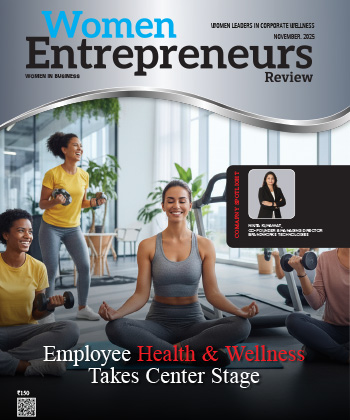
Women Leaders Redefining HR Innovation with Empathy & Impact
By: Aditi Mittal, Group Head - HR, SAVE Solutions
Aditi Mittal is a seasoned HR leader with over 20 years of expertise in organizational transformation, talent acquisition, and workforce scaling. Known for championing diversity and building future-ready talent pipelines, she positions HR as a strategic enabler while fostering people-first, inclusive workplace cultures.
In an engaging interaction with Women Entrepreneurs Review Magazine, Aditi shares practical insights gained as the HR leader of Banking Correspondent (BC) platform, SAVE Solutions. She talks about inclusive hiring during hyper-growth, people-first strategies in M&A, and how storytelling can empower women leaders in HR and comms to build trust and inspire culture.
How did you ensure inclusive hiring and retention practices while scaling from 600 to 4,000+ employees? What factors must be prioritized during such hyper-growth phases?
Scaling isn’t just about adding numbers. It’s about multiplying possibilities—for people, by people.
At SAVE, growing from 600 to 4,000+ employees across five distinct entities meant we had to embed inclusion not as an initiative, but as infrastructure. We built this by: Institutionalizing gender balance KPIs into hiring dashboards,Sourcing from local and semi-urban talent pools to build rooted teams, and ensuring equal access to training and leadership tracks for all employees.
We created a scalable HR playbook that balanced speed with sensitivity, automation with human connection.
For women leaders in hyper-growth, my advice is: “Automate what can scale, but never outsource empathy.” Build decentralized systems that empower local leadership and nurture feedback loops early. Inclusivity becomes real when policies and practices grow in sync with people’s aspirations.
In the context of your M&A experience, what people-first strategies helped unify diverse organizational cultures, especially for women employees navigating uncertainty or transition?
M&As test not just strategy but soul. Culture isn’t integrated—it’s harmonized.
With SAVE Group’s M&A integrations, including Housing and MSME entities, we adopted a “One SAVE” framework rooted in transparency and respect for legacy systems.
Key people-first strategies included:
Cultural audits followed by co-created value frameworks
Retention of women-centric policies across entities (maternity benefits, POSH protocols, mensuration leaves)
Peer mentorship circles and “culture champions” to build emotional safety
For women employees navigating uncertainty, we made sure the message was clear: “Your growth and safety are non-negotiable.”
My learning: don’t rush uniformity. Inclusion during transitions starts with listening, continues with co-creation, and thrives on trust.
You introduced micro learning to engage modern attention spans. How can such innovations be leveraged to create equitable skill-building environments for frontline and remote teams?
Learning should not depend on bandwidth—technological or mental.
We deployed mobile-first, multilingual microlearning modules that reached over 85 percent of our frontline workforce, with a strong focus on women employees in rural branches. These modules, originally 5–7 minutes, were later refined into 1–2 minute capsule videos, recognizing the constraints of attention span and operational workload.
Co-created with internal subject matter experts and rooted in real-life scenarios, this initiative ensured that learning was not only accessible but also relevant and actionable at the grassroots level. It transformed training from a top-down mandate into a community-led learning culture, bridging skill gaps in real time and empowering our distributed teams.
This approach democratized upskilling. It increased training completion rates by 60 percent in hard-to-reach areas, and enabled just-in-time learning, boosting confidence among field teams.
For HR leaders, this is a reminder: “Innovation doesn’t always mean new tech. Sometimes, it’s about relevance, accessibility, and representation.”
Engage local voices, respect lived realities, and empower your teams to be both learners and teachers.
With no marketing spend; you’ve built a top BFSI LinkedIn brand. How can women leaders in HR and comms use storytelling to humanize internal culture and inspire external trust?
Stories build brands. People build stories. And trust builds both.
At SAVE, we amplified internal voices—grassroots stories, local achievements, impact narratives—with zero marketing budget, relying purely on authenticity. Every story was a signal of what we value, not just what we achieve.
This strategy not only tripled our LinkedIn engagement organically but also attracted top-tier talent without recruitment ads. It also earned SAVE recognition as one of the most followed NBFC-MFIs.
For women leaders, storytelling is your power. “Use it to shift culture from the inside out, not just narrate it from the outside in.” Align HR and comms—when your people trust you internally, your brand resonates externally.
In high-turnover zones, you cut attrition by 20%. Can you share a specific example of a localized, gender-sensitive intervention that helped create a safer, more committed work environment?
Retention isn’t about locking people in—it’s about making them want to stay.
In rural geographies, we introduced Women Champions—local female staff trained in HR and basic counselling. They became first responders for mobility issues, harassment, and grievances, creating a trusted safety net.
Key outcomes were 20 percent drop in attrition in high-turnover zones, enhanced POSH compliance awareness at grassroots level, and increased reporting of silent issues, especially by junior female staff.
We also offered seasonal flexibility around harvest times, recognizing local family structures and commitments. Localized empathy created systemic impact.
The takeaway: standard policies don’t work everywhere. Hyper-local and gender-aware interventions do.
What advice would you give women leaders in HR or communications who want to drive both business impact and social inclusion through their roles?
“Don't just earn a seat at the table—change what’s served there.”
Women leaders in HR and comms have a unique vantage point to link business outcomes with inclusion.
Every people initiative—from recruitment to rewards—must tie back to strategy and societal value.
Here’s what I’ve learned:
Design metrics for inclusion, not just efficiency
Speak data, but also speak heart
Innovate boldly—even the most impactful interventions I’ve led started as unsanctioned pilots backed by insight and belief.
And most importantly: “Don’t wait for consensus to lead with conviction. Influence the narrative. Shape the future—not in silos, but in systems.”
Most Viewed
- 1 Women's Health Startup HerMD Closing Doors Amid Industry Challenges
- 2 5 Famous Women in Indian Armed Forces
- 3 Saudi Women No longer Require Male Permission for Clothing Choices, says Prince MbS
- 4 Kolkata Medtech Startup Innovodigm Raises Rs 5.5 Crore Seed Funding Led by IAN Group
- 5 Yamunanagar's Kashish Kalra Honoured after Securing 111th Rank in UPSC Civil Services Exam
- 6 Madurai Appoints Its First Woman Corporation Head
- 7 IAS Vijayalakshmi Bidari Appointed as the new Nagpur Divisional Commissioner
- 8 American Entrepreneur Lucy Guo Overtakes T Swift to become Youngest Female Billionaire
- 9 ICC Women's World Cup 2025 Trophy Showcased at Indore's Holkar Stadium
- 10 Aparna Saxena's Beauty Venture AntiNorm Launches in India
- 11 Vidya Nataraj Co-Founded BlueStone Jewellery & Lifestyle files IPO
- 12 5 Women Freedom Fighters of India
- 13 Dr. G Krishnapriya appointed as CEO for Trichy
- 14 M3M & Sirona Partner to Introduce Menstrual Hygiene Vending Machines in 15 Locations
- 15 Punjab Govt launches SHE Cohort 3.0 Supporting Tech-led Women Startups
- 16 Indian origin Lawyer, Sweena Pannu appointed as the US New Superior Court Judge
- 17 The Aurora Tech Award recognizes 4 Indian Women-led Startups
- 18 Kerala's Republic Day parade featured an all-female tableau
- 19 Manisha Kabbur Becomes Karnataka's First Woman International Karate Coach
- 20 Director K. S. Ravikumar's Daughter Maalica Ravikumar Launches Life Coaching Company 'Evergrowth Academy' for Women
- 21 Leezu's Raises Pre-Seed Funding to Accelerate Growth in Sexual Wellness Industry
- 22 Sattu: Super-easy summer drink for PCOS gut healing
- 23 Swathi Nelabhatla creates Sitha App, India's First Women-Exclusive Gig Platform
- 24 7 Timeless Female Kathak Dancers & their Iconic Legacies
- 25 Meet 7 Iconic Women Architects of Modern India & their Most Impactful Work
- 26 This Woman-led Insuretech Startup is Helping Bridge the Education Financing Gap in India
- 27 Women Leaders Share Lessons Learnt from India Women's WC Win
- 28 5 Enterprising Women Founders Powering Singapore's Tech & Innovation Landscape
- 29 4 Women. 4 Stories. One Vision for Smarter, Stronger Healthcare
- 30 Global Gender Gap Narrows to 68.8%, But Full Equality 123 Years Away: WEF Report 2025
- 31 Changemakers: 7 Women Entrepreneurs Taking the Make in India Movement Forward
- 32 Meet Lucy Guo, The Youngest Self-Made Female Billionaire Disrupting Tech
- 33 How Women are Driving India's Festive Online Shopping Surge






